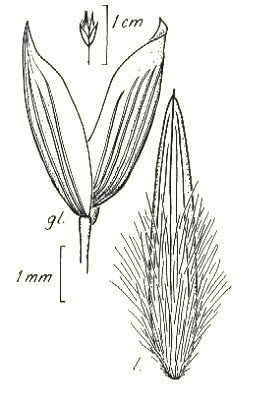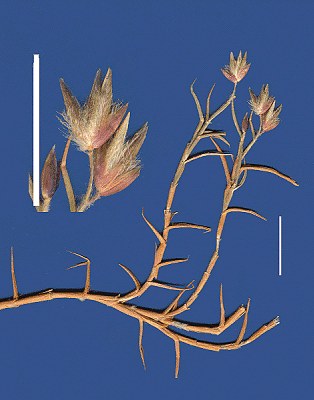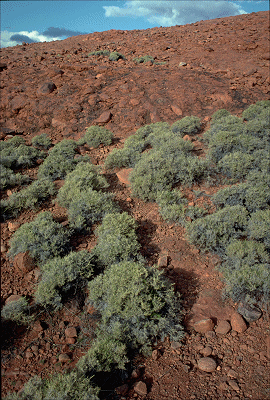Eriachne scleranthoides F. Muell. Fragm.
8: 233 (1874).
Classification. (GPWG 2001) : Subfamily
Micrairoideae. Eriachneae.
Type of Basionym or
Protologue Information: HT: E. Giles s.n., Sep 1873, Australia:
Northern Territory: Central Australia, Mt. Olga (MEL; IT: B, BRI, K,
US-734055).
Key references
(books and floras): [1878] G.Bentham, Flora Australiensis 7 (631),
[1981] M.Lazarides in J.Jessop (ed)., Flora of Central Australia (441),
[2002] D.Sharp & B.K.Simon, AusGrass, Grasses of Australia.
Habit.
Perennial. Culms 60–105 cm tall, woody. Lateral branches branched. Ligule a
fringe of hairs. Leaf-blades erect or spreading or recurved, straight or
curved, flat or conduplicate, 2.5–12 cm long, 0.5–1 mm wide. Leaf-blade surface
smooth, glabrous or indumented.
Inflorescence.
Inflorescence compound, of only a few spikelets.
Spikelets.
Spikelets pedicelled. Basal sterile spikelets absent or rudimentary, 0–2 in
number. Fertile spikelets 2-flowered, both fertile, comprising 2 fertile
floret(s), without rachilla extension, ovate, laterally compressed, 3–5 mm
long.
Glumes.
Glumes similar, thinner than fertile lemma. Lower glume ovate, membranous,
without keels, 7–9 -nerved. Lower glume surface glabrous. Lower glume apex
mucronate. Upper glume ovate, 3.5–4.25 mm long, membranous, without keels, 7–9
-nerved. Upper glume surface smooth, glabrous. Upper glume apex mucronate.
Florets.
Fertile lemma 4–5.5 mm long, without keel, 5–7 -nerved. Lemma surface
indumented. Lemma apex muticous. Palea 2 -nerved. Palea apex entire or dentate.
Continental
Distribution: Australasia.
Australian
Distribution: Northern Territory, Queensland.
Northern Territory:
Central Australia South. Queensland: Burke, Gregory North, Gregory
South, Mitchell.
Notes.
An extremely distinctive species due to its xerophytic shrubby compact habit,
woolly indumentum on culms and basal cataphylls, completely covered (by
overlapping leaf sheaths) culms of numerous nodes and very short internodes,
short rigid long-spiny finally recurved blades, reduced scarcely exserted
inflorescences, awnless florets with appressed lemma and palea that are longer
than glumes, minute obtuse bearded callus, and glabrous smooth mucronate glumes
almost as wide as long, which are widely divergent at maturity. Eriachne
scleranthoides closely resembles the xerophytic forms of E. mucronata,
but differs by its florets that are longer than the glumes, often muticous
lemmas evenly narrowed to the apex (abruptly mucronate in E. mucronata),
woolly (not hispid) culms, finally recurved (not straight) blades with a longer
apical spine, longer anthers (3–4 mm, not c. 2.6 mm), and its inflorescences
are much reduced (to 1–3 spikelets) and scarcely exserted, compared with the
relatively well-developed prominently exserted panicles of E. mucronata.
Endemic.
Known from two localities in SW central Australia. Conglomerate monoliths (Mt
Olga and Mt Currie) on crests, scree slopes, in chasms and crevices, in shallow
sand, gravelly slopes or shallow stony red soil, sometimes in seepage from
massive boulders. Flowers May (late-autumn) and Aug.-Oct. (late-winter to
mid-spring).





